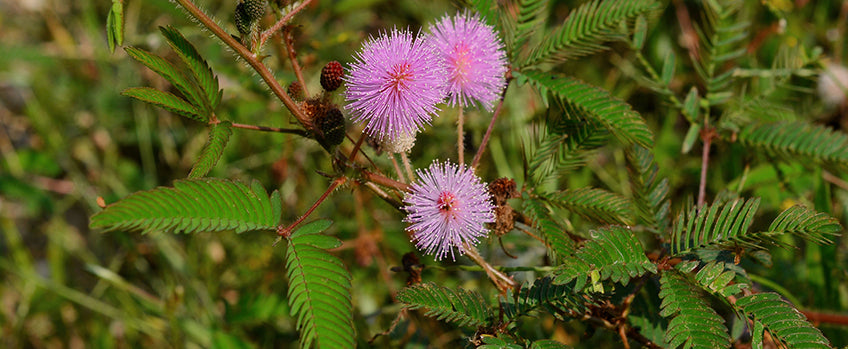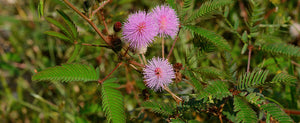Growing Mimosa pudica From Freshly Harvested Seeds!
Oct 31, 2017

Growing Mimosa Pudica:
Mimosa Pudica is a creeping, perennial type of flowering herb that is from the pea Fabaceae is a plant that many people chose to grow for its curiosity value. Mimosa Pudica has compound-style leaves that fold inward and droop when the plant is touched or shaken in any way. This is how the plant defends itself from harm and the leaves will reopen a few minutes later. This plant is generally grown mostly in South and Central America but is also sometimes a type of pantropical weed. Other places that this plant can grow include areas widespread as Bangladesh to Indonesia and Thailand or even Japan as well as many other countries throughout Asia. It also grows in more “tropical” climates from Florida or Georgia in the US.
How Should I Sow the Seeds?
The average seed for a Mimosa Pudica plant should be planted at a depth of about 1/8 inches. You should plan on putting 2-3 seeds down for each plant that you want to see grow. Each plant should be spaced a minimum of 15 inches apart to allow adequate room for sprouting and growth.
What Are the Moisture/Soil/Sunlight Requirements?
It is recommended that you soak the Mimosa Pudica seeds in water for 24 hours before you wish to plant them. The flower’s seeds will need to be kept moist until the seed sprouts and begins to grow. Cover the pots or soil with a clear plastic to help hold the moisture in. The plastic should be removed soon as the seed begins to sprout through the soil.
The Mimosa Pudica does the best in a fully sunny to the partially-shady environment. Plan on providing the plant with rich, moist soil of a pH of 6.6 to 7.5 for the best quality environment for the plant to grow in.
The seeds will germinate the most rapidly in temperatures at about 70 degrees and in dry conditions plants may begin to grow in soon as a week. However, in hotter, more humid climates the seeds may take 2 to 4 weeks to sprout rather than just the normal week.
Be sure to protect the plant against colder night temperatures that may include frosts as this makes the seeds more fragile and slower to grow. Never let the seed be exposed to direct frost or it may ruin the seed’s ability to germinate at all.
Fertilizer may be used once per week during the growing season and once per month during the winter. Be sure to avoid direct contact with the roots when fertilizing your plant.
Can Mimosa Pudica Plants Be Houseplants?
Mimosa Pudica plants can be grown indoors in direct sunlight in places such as your window sill. However, the plant is often considered a level #4 toxicity in poisonous so you should wash your hands with soap and warm water thoroughly after touching any part of the plant, even if only for a brief period of time. Keep the plant away from any house pest or children as ingestion of the plant is very toxic and poisonous.
Growing Your Plant Inside:
If you choose to grow your Mimosa Pudica as a household plant remember to be sure to transfer the plant to an adequate-sized pot as it continues to grow. Leaving the plant in a pot that is too small will stop the roots from being able to spread and branch out thus stunting the growth of your plant.
Typical Height & Width etc.:
The average Mimosa Pudica plant grows to be about 5 feet tall and about 3 feet wide when they are in full bloom. This is why it is recommended to plant seeds at least 15 inches apart to allow the plant adequate room to blossom and grow when it germinates.
It’s worth noting, however, that in more temperate growing climates its more likely that a fully germinated Mimosa Pudica plant will reach about half of this potential size. That means you are looking at a plant about 2 ½ feet tall and about 1 ½ feet wide rather than the possible 5-foot-tall and 3-foot-wide plant that otherwise might grow in the most optimal growing environments.
The Mimosa Pudica Plant’s Sensitivity to Touch:
The Mimosa Pudica plant is a very sensitive plant that will curl up and droop its flowers when touched. This is a defense mechanism that the plant has to protect itself from predators. The leaves will drop when touched or rattled by movement, however, they will generally open up again a few moments later.
The leaves also assume a folded or sleeping posture at night. The leaves also snap shut very rapidly due to their defense mechanism to help protect the plant and keep it safe. The plant is very sensitive so its recommended to avoid any trauma by suddenly shaking or moving the plant or touching it unless absolutely necessary to care for it. This will help preserve the plant for longer.
Other Information on Mimosa Pudica Plants?
The Mimosa Pudica plant is also known as a “touch-me-not” due to its sensitive nature and the fact that when it’s touched that both the flower and the leaves shrivel up into a ball to protect the plant from perceived predators. The plant will return to its normal state within a few moments of the impact from any touch or movement that it may have to endure.
The Mimosa Pudica plant can last for up to 2 years in the tropical climates where it originally thrived, however, is considered an annual plant when it is planted in more temperate zones. If the plant can survive past the summer you will actually have better results letting the plant die off and replanting it the next summer.
When the plant dies off you can collect the seeds to save for the next growing season. To do this dig up the seed pods and let them dry. Once they dry, crack the seed pods open and retrieve the seeds. Save them to grow again the next summer.
What Other Uses Does Mimosa Pudica Have?
Mimosa pudica is also used for many sorts of medical treatments in addition to its ornamental value and interesting, attractive nature. The leaves are also often used in many different medicines and remedies to help treat certain conditions.
The leaves often make pastes that help treat everything from swelling to wounds or insect bites, itching, piles, and other skin conditions.
The Mimosa Pudica plant can also be turned into a type of juice that can be consumed, usually in about a 15 to 30-milliliter quantity to help treat conditions ranging from diabetes to asthma and high blood pressure. Some studies show that this plant can even help men with premature ejaculations.
Many people who are into “herbology” or using herbs rather than traditional remedies will grow Mimosa Pudica in their gardens or even in pots in their homes to help make all natural remedies to help treat any health conditions they or loved ones may face. Many people prefer using plants like the Mimosa Pudica to pharmaceutical drugs that would be prescribed by a doctor as they often have less side-effects and are more organic in nature.

